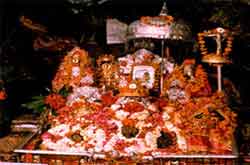Ladakh - Lifestyle & Culture
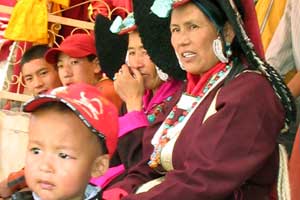 People & Lifestyle - Like the land itself, the people of Ladakh are generally quite different from those of the rest of India. The faces and physique of the Ladakhis, and the clothes they wear, are more akin to those of Tibet and Central Asia than of India. The original population may have been Dards, an Indo-Aryan race down from the Indus and the Gilgit area.
People & Lifestyle - Like the land itself, the people of Ladakh are generally quite different from those of the rest of India. The faces and physique of the Ladakhis, and the clothes they wear, are more akin to those of Tibet and Central Asia than of India. The original population may have been Dards, an Indo-Aryan race down from the Indus and the Gilgit area.
But immigration from Tibet, perhaps a millennium or so ago, largely overwhelmed the culture of the Dards and obliterated their racial characteristics. In eastern and central Ladakh, today's population seems to be mostly of Tibetan origin. Further west, in and around Kargil, the people's appearance suggests a mixed origin.
The exception to this generalisation is the Arghons, a community of Muslims in Leh, originated as a result of marriages between local women and Kashmiri or Central Asian merchants. They exhibit a marked dominance of the Indo-Aryan trait in their physique and appearance, though culturally they are not different from the rest of the Ladakhis.
Ladakh Culture - The people of Ladakh, by and large, exhibit a natural joie-de-vivre, which is given free rein by the region’s ancient traditions.
Socio-religious festivals, including the annual festivals held in the monasteries, provide the excuse for convivial gatherings. Archery is a pastime for all in summer. Among the Buddhists this sport often takes the form of open-air parties accompanied by dance and song. The game of Polo is yet nother proud element of the popular culture.
Archery and Polo - Archery is an ancestral sport of Ladakh, which is part of the culture. In Leh and its surrounding villages, archery festivals are held during the summer months, with a lot of fun and fanfare. They are competitive events, to which all the surrounding villages send their teams.
The sport itself is conducted with strict etiquette, to the accompaniment of the music of surna and daman (oboe and drum). As important as the sport itself are the interludes of dancing and other entertainment. Chang, the local barley beer, flows freely, but there is rarely any rowdiness. The crowds attend in their Sunday best, the men invariably in traditional dress and the women wearing their brightest brocade mantles and their heaviest jewellery. Archery may be the pretext for the gathering, but partying is the thing. In Kargil area, on the other hand, the archery competitions are more serious and bereft of the dancing and music, and these are held in early spring, at the time of the thawing of the winter snow and frost.
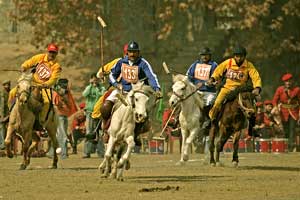 Polo, the other traditional sport of Ladakh is indigenous to the western Himalayas, especially to Baltistan and Gilgit. It was probably introduced into Ladakh in the mid-17th century by King Singge Namgyal, whose mother was a Balti princess. The game played here differs in many respects from the international game, which is adapted from what British travellers saw in the western Himalayas and Manipur in the 19th century. Each team consists of six players, and the game lasts for an hour with a ten-minute break. Altitude notwithstanding, the hardy local ponies - the best of which come from Zanskar – scarcely seem to suffer, though play can be fast and furious. Each goal is greeted by a burst of music from surna and daman, and the players often show extraordinary skill. Unlike the international game, polo in Ladakh is not exclusively for the rich.
Polo, the other traditional sport of Ladakh is indigenous to the western Himalayas, especially to Baltistan and Gilgit. It was probably introduced into Ladakh in the mid-17th century by King Singge Namgyal, whose mother was a Balti princess. The game played here differs in many respects from the international game, which is adapted from what British travellers saw in the western Himalayas and Manipur in the 19th century. Each team consists of six players, and the game lasts for an hour with a ten-minute break. Altitude notwithstanding, the hardy local ponies - the best of which come from Zanskar – scarcely seem to suffer, though play can be fast and furious. Each goal is greeted by a burst of music from surna and daman, and the players often show extraordinary skill. Unlike the international game, polo in Ladakh is not exclusively for the rich.
Traditionally, almost every major village had its polo-ground, and even today it is played with verve in many places besides Leh, especially in Dras and Chushot near Leh. In Leh town itself, it has been partly institutionalised with regular tournaments and occasional exhibition matches being played on the polo-ground. The local crowd takes a keen interest, especially in those matches in which a civilian team takes on that of the army. Altogether, polo adds a unique kind of colour and excitement to the summer in Leh.
Oracles and Astrologers - The people of Ladakh, particularly the Buddhists, believe implicitly in the influence of gods and spirits on the material world, and undertake no major activity without taking this influence into consideration. The lamas are the vital intermediaries between the human and the spirit worlds. Not only do they perform the rites necessary to propitiate the gods, but they also take on the role of astrologers and oracles who can predict auspicious time for starting any work, whether ploughing the fields, or taking in the harvest, arranging a marriage or going on a journey.
The most famous monk-oracles are those of Matho Gompa. Chosen every three years by a traditional procedure, two monks spend several months in a rigorous regimen of prayer and fasting to prepare and purify themselves for their difficult role. When the time comes they are possessed by the deity known as Rong-tsan, whose spirit enables them to perform feats that would be impossible to anyone in a normal state such as cutting themselves with knives, or sprinting along the Gompa's topmost parapet. In this condition, they will answer questions concerning individual problems and public welfare.
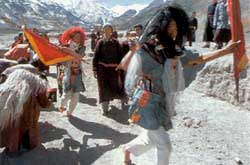 However, the spirit is said to be able to detect questions asked by skeptical observers for testing him, to which they react with frenzied anger.
However, the spirit is said to be able to detect questions asked by skeptical observers for testing him, to which they react with frenzied anger.
In some villages there are also lay people who have special powers as oracles and healers. Some of them belong to families in which there have been several such recipients of spirit forces, while others do not have any such hereditary background. The spirits possessing these laypersons are believed to be unpredictable, and not always entirely benevolent, and some people resist being possessed by them. However, once they have accepted, they undergo a process of initiation and training by monks and senior oracles before they are able to start practising.
Arts and Crafts - The tradition of artistic craftsmanship in Ladakh is not as well developed as in neighbouring Kashmir, and most of the luxury articles are obtained through imports.
The exception is the village of Chiling, about 19 km up the Zanskar River from Nimo, where a community of metal workers carry on their ancestral profession, working with silver, brass and copper. These are said to be the descendants of artisans brought from Nepal during the mid-17th century to build one of the gigantic Buddha - images at Shey. They produce exquisite items for domestic and religious use, such as tea and chang pots, teacup-stands and lids, hookah-bases, ladles, bowls and occasionally, silver chortens for temples and domestic shrines.
Items of everyday use such as cooking pots and bowls, as well as agricultural implements are supplied by local blacksmiths (gara). They also make the large and ornate iron stoves seen in kitchens of the Ladakhi homes. Craftsmanship in general has not developed beyond the production of everyday items for domestic use. Pattu, the rough, warm, woollen material used for clothing is made from locally produced wool, spun by women on drop-spindles, and woven by traditional weavers on portable looms that are set up in the winter sunshine or under the shade of a tree in summer. Baskets, for the transport of any kind of burden, are woven out of willow twigs or a particular variety of grass. Woodwork is confined largely to the production of pillars and carved lintels for the houses and the low carved tables or Chog-tse that are a feature of every Ladakhi living room.
Many such items, including newly introduced varieties, are available in the Government Handicrafts Centre at Leh. There you can find, in addition to traditional objects, a few special items like pure pashmina shawls, rough compared with those produced in Srinagar, and carpets with Tibetan designs. Similar carpets can also be purchased at the Tibetan Refugee Centre, Choglamsar. The Handicrafts Centre also has a department of thangka painting. These icons on cloth are executed in accordance with strict traditional guidelines handed down the generations.
In the same tradition are the mural paintings in the monasteries, where semi-professionals, both monks and laymen, toil to keep the walls decorated with images symbolising various aspects of Buddhism. The skill of building religious statues is also not extinct. The gigantic image of Maitreya Buddha was installed in Thiksey Gompa as recently as the early 1980s.

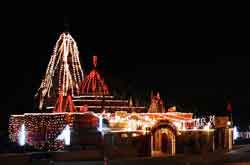
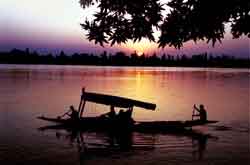
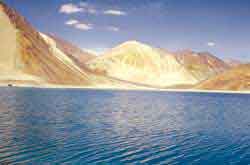
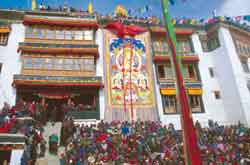
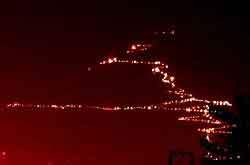
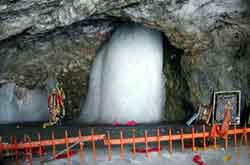
 People & Lifestyle - Like the land itself, the people of Ladakh are generally quite different from those of the rest of India. The faces and physique of the Ladakhis, and the clothes they wear, are more akin to those of Tibet and Central Asia than of India. The original population may have been Dards, an Indo-Aryan race down from the Indus and the Gilgit area.
People & Lifestyle - Like the land itself, the people of Ladakh are generally quite different from those of the rest of India. The faces and physique of the Ladakhis, and the clothes they wear, are more akin to those of Tibet and Central Asia than of India. The original population may have been Dards, an Indo-Aryan race down from the Indus and the Gilgit area. Polo, the other traditional sport of Ladakh is indigenous to the western Himalayas, especially to Baltistan and Gilgit. It was probably introduced into Ladakh in the mid-17th century by King Singge Namgyal, whose mother was a Balti princess. The game played here differs in many respects from the international game, which is adapted from what British travellers saw in the western Himalayas and Manipur in the 19th century. Each team consists of six players, and the game lasts for an hour with a ten-minute break. Altitude notwithstanding, the hardy local ponies - the best of which come from Zanskar – scarcely seem to suffer, though play can be fast and furious. Each goal is greeted by a burst of music from surna and daman, and the players often show extraordinary skill. Unlike the international game, polo in Ladakh is not exclusively for the rich.
Polo, the other traditional sport of Ladakh is indigenous to the western Himalayas, especially to Baltistan and Gilgit. It was probably introduced into Ladakh in the mid-17th century by King Singge Namgyal, whose mother was a Balti princess. The game played here differs in many respects from the international game, which is adapted from what British travellers saw in the western Himalayas and Manipur in the 19th century. Each team consists of six players, and the game lasts for an hour with a ten-minute break. Altitude notwithstanding, the hardy local ponies - the best of which come from Zanskar – scarcely seem to suffer, though play can be fast and furious. Each goal is greeted by a burst of music from surna and daman, and the players often show extraordinary skill. Unlike the international game, polo in Ladakh is not exclusively for the rich. However, the spirit is said to be able to detect questions asked by skeptical observers for testing him, to which they react with frenzied anger.
However, the spirit is said to be able to detect questions asked by skeptical observers for testing him, to which they react with frenzied anger.